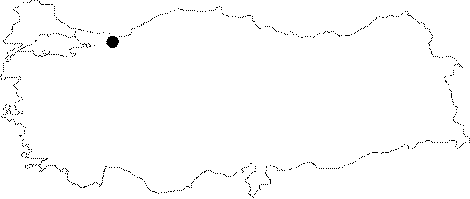|
|
||||
|
|
||||
|
Yenimahalle |
||||
|
For cave maps and drawings please click on the picture... |
For photographs please click on the photo... |
|||
|
 |
|||
|
Type: |
Cave | |||
|
Altitude: |
360 m | |||
|
Depth: |
-13 m | |||
|
Length: |
360 m | |||
|
Region: |
Black Sea | |||
|
Province: |
Düzce | |||
|
District: |
Akçakoca | |||
|
Village: |
Merkez | |||
|
|
||||
 |
||||
| Location: It is located on the basin of a round shape pit in Yenimahalle; inside Akçakoca at the Black Sea coast; 40 km north of Düzce. CVurrently it is among the houses. |
| Structural Properties and formation : It is an active/semi-active cave developed inside the aged limestones. It consists of two sections. The entrance section in east-west direction consists of two galleries and it is the sinkhole type; semi-active section of the cave. It is 0.5-3 m wide; and 1-4 m high. The basin of the semi-active section is filled with sand; pebbles; and debris. The sinkhole gallery in east-west direction connects with the active section; which lies 100 m further down. It contains a continuously flowing subsurface stream. The gallery comes from the northern direction to make large "S" curves. The northern end is 200 m long; at -6m from the sinkhole type entrance; and the beginning of the gallery. The subsurface stream comes from that point which is covered by large blocks. The waters form 3 m deep lakes; small waterfalls; and dripstone ponds; then leave the cave through the closed siphon. The passage type gallery filled with dripstone formations such as stalactites; stalagmites; curtains; columns; and eccentrics; with a width of 1-5 m; and a height of 1-6m; consists of two sections. The section from the beginning to the sinkhole galleries' meeting point is the cleanest part of the cave which is filled with water wear structures; and dripstone formations. On the other hand the second section where the waters from the sinkhole and the subsurface waters flow together to the siphon; is also the section stuffed with alluvium. |
| Research History: It was researched by the Geological Studies Department Presidency of the MTA General Directorate and published in 2002. |
| Findings: Presence of living animals from outsie the cave was observed due to the nearness to the surface and an area covered with dense woods and a thick layer of soil. Those are mainly frogs; small crabs; and flies. On the other hand bats; and dark color mollusks were observed in some parts of the active gallery. |
